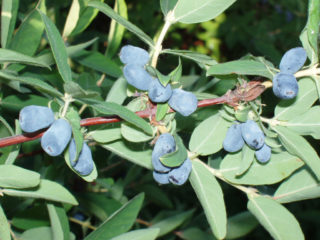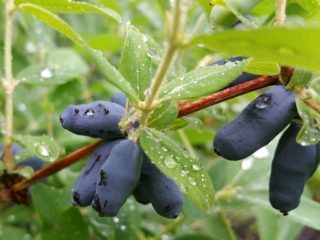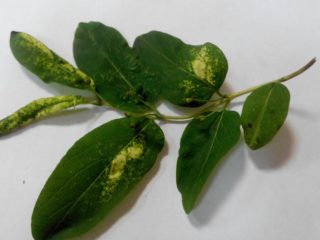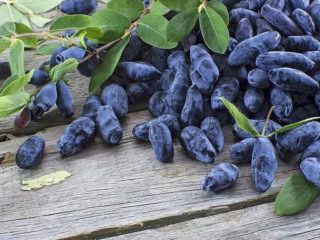Content
Garden honeysuckle is grown for its early and very healthy berries. It was bred on the basis of edible species growing in the Far East, Western Siberia, China and Korea. In regions close to their natural habitat, the shrub requires minimal care. But recently, just as grapes are “moving” to the North, honeysuckle is being planted in the southern regions. And there the crop suffers from the heat, grows and bears fruit poorly. Adaptation to an unusual climate continues, and the soil for honeysuckle plays an important role in this process.

Edible honeysuckle is easily recognized by its blue berries.
What soil does honeysuckle prefer?
In harsh climates, honeysuckle is an unpretentious plant that can tolerate some shading, frost and does not require special care. In the south, most varieties wither away. Many gardeners attribute this to the composition of the soil, but they are only partly right.
In various, even very authoritative, sources, one can find seemingly opposite recommendations regarding the preparation of planting mixture for honeysuckle. Some advise adding lime or a large amount of ash to the pit, which in itself alkalizes the soil.Others argue that honeysuckle loves acidic soil.
In fact, the culture is very undemanding to the composition of the soil. The pH of the soil for honeysuckle varies in a wide range - 4.5-7.5, that is, it can have a reaction from moderately acidic to slightly alkaline.
Usually, residents of the North-West, Siberia, and the Far East do not even think about its composition when planting honeysuckle in open ground. But southerners complain: honeysuckle does not grow well in black soil.
Chernozem can be different. Yes, it contains a lot of humus and is highly fertile. But, for example, the richest loam in composition turns into plasticine during rains, and during drought it becomes hard as stone and cracks. It is not for nothing that the inhabitants of the black earth zone also improve their soils.
The soil for garden honeysuckle should be loose, well permeable to air and water. Short-term wetness or drought should not disturb its structure.
What happens when planting honeysuckle in black soil? The root of the crop, although taprooted, is short - only 50 cm. And there are many lateral shoots. During drought, hardened and cracked soil literally tears away the thin fibrous roots. And during periods of rain or active watering, it turns into a heavy sticky mass, impenetrable to air.
This isn't just a problem for honeysuckle. Sometimes the owners, having brought clean loamy black soil to the site, which is indeed the most fertile, believe that they were deceived. And they don’t know what to do with the land. It is necessary to improve its structure from season to season.And honeysuckle simply suffers more than other crops, because it is absolutely not adapted to such soil conditions.
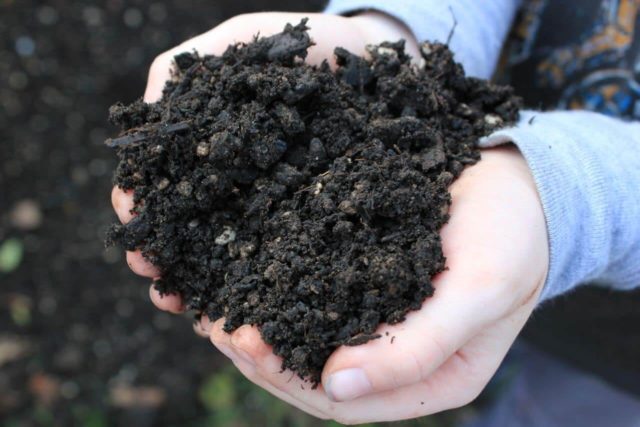
Loamy chernozem is the most fertile, but needs structuring
The structure of loamy chernozem can be improved by regularly, once every few years, adding lime. Or additives that increase soil permeability, for example, humus and acidic peat, which has a fibrous structure.
Honeysuckle actually grows better if one of the listed additives is present in the planting hole. But not because of acidity correction. Lime, humus and acidic peat improve the soil structure. And this is of great importance for culture.
Composition of soil for honeysuckle
The soil for garden honeysuckle should be well structured. To check whether it needs improvement, you need to cut off at least 10 cm of the fertile layer with a shovel and throw it up. Carefully inspect the fallen layer:
- there is a whole pancake on the ground, from which several pieces bounced off when hit - a lot of clay;
- the formation has completely crumbled - too much sand;
- the top layer of soil has broken up into lumps of different sizes, grains, grains - a good structure.
Heavy clay soils do not allow moisture and air to pass through well. After watering and rain, a crust forms on the surface, and water stagnates in the root area. This is unacceptable for honeysuckle. This happens on rich black soils. That is why they are not suitable for growing crops.
Sandy soil dries out quickly and nutrients are washed out of it.Water-soluble fertilizers go to the lower layers without having time to act.
If the soil is not suitable for the crop, you need to prepare a fertile mixture yourself. For honeysuckle one of the following options is suitable:
- humus and middle (black) peat in equal parts;
- turf soil, peat (sand), humus, proportions – 3:1:1.
On alkaline soils, it would be useful to add high-moor (red) peat to the planting hole. For acidic soils, ash or lime are good additions.
How to prepare the soil for honeysuckle
In the natural growth area of the crop, it is enough to plant the bush in ordinary soil in a sunny place. If the soil becomes soggy, drain the water or arrange good drainage. To improve fertility, add a bucket of humus and 50 g of potassium and phosphate fertilizers to each planting hole. On well-structured but poor soils, organic matter is applied 2 times more.
It is more difficult on soils that are too dense, including chernozems and sandy loams. Here you need to dig a planting hole with a depth and a diameter of at least 50 cm. It is better to completely replace the soil with one of the soil mixture options presented above.
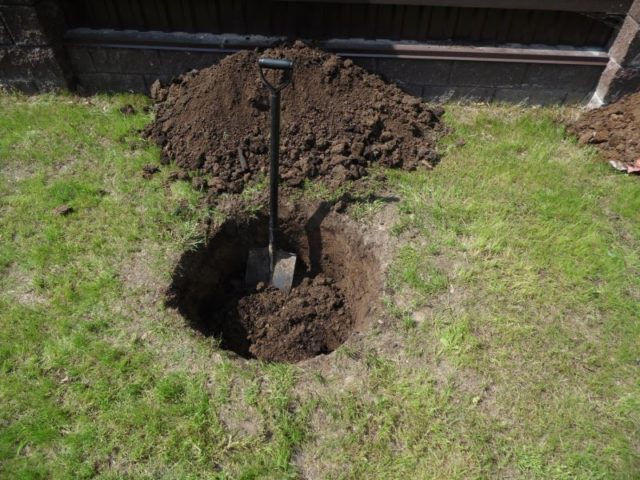
On unsuitable soils, the planting hole is filled with self-prepared substrate
Advice from experienced gardeners
Practicing gardeners who grow honeysuckle in regions unfavorable for the crop advise:
- When improving the structure of heavy soils, only coarse sand can be used. The small one glues the ground together and will only worsen the situation.
- When preparing a soil mixture, you cannot simply mix the components. It is recommended to sift them through a large sieve and add fertilizer.And only then fill the landing pit. Many gardeners neglect this rule, and then cannot understand what went wrong. For honeysuckle, the operation is of great importance.
- When sifting the components of the soil mixture, you can use a mesh from an old armored bed. It is installed on supports, peat, sand, humus, and turf soil are thrown in. If you come across large lumps, you can immediately break them up by hitting them flat with a shovel.
- Humus is taken from horse and cattle. Pig access to the garden should be prohibited. Bird droppings are suitable for liquid fertilizing; they should not be placed in the planting hole.
- If in regions with a cool climate honeysuckle is planted in a sunny place, then in the south the crop requires shading. It’s already too hot for her there, and in direct sunlight the bush will try to survive, and there will simply be no strength left to set fruit. It’s good if, on the south side of the honeysuckle, there is a tree with an openwork crown, a trellis, a lattice gazebo, or a net stretched with a climbing plant planted nearby.
The farmer talks about the autumn planting of honeysuckle and blueberries, and also shows how to prepare the soil mixture using an armored mesh:
Conclusion
The soil for honeysuckle should be fertile and structured. The culture is undemanding to acidity and can grow at pH levels from 4.5 to 7.5. The soil that is unsuitable for honeysuckle must be removed from the planting hole and filled with a self-prepared mixture.


